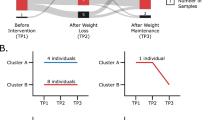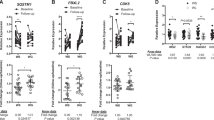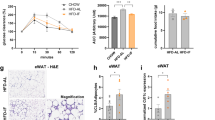Abstract
Background/objective:
Weight loss is often followed by weight regain after the dietary intervention (DI). Cellular stress is increased in adipose tissue of obese individuals. However, the relation between cellular stress and weight regain is unclear. Previously, we observed increased adipose tissue cellular stress of participants regaining weight compared with participants maintaining weight loss. In the current study, we further investigated the relation between weight regain and changes in the expression of stress-related genes and stress protein levels to determine possible predictors of weight regain.
Participants/methods:
In this randomized controlled trial, sixty-one healthy overweight/obese participants followed a DI of either a 5-week very-low-calorie diet (500 kcal per day) or a 12-week low-calorie diet (1250 kcal per day; WL period) with a subsequent 4-week weight stable diet (WS period), and a 9-month follow-up. The WL and WS period taken together was named the DI. Abdominal subcutaneous adipose tissue biopsies were collected in 53 participants for microarray and liquid chromatography-mass spectrometry analysis. RNA and protein levels for a broad set of stress-related genes were correlated to the weight regain percentage.
Results:
Different gene sets correlated to weight regain percentage during WS and DI. Bioinformatics clustering suggests that during the WS phase-defined genes for actin filament dynamics, glucose handling and nutrient sensing are related to weight regain. HIF-1 (hypoxia-inducible factor-1) is indicated as an important regulator. With regard to DI, clustering of correlated genes indicate that LGALS1, ENO1 and ATF2 are important nodes for conferring risk for weight regain.
Conclusions:
Our present findings indicate that the risk for weight regain is related to expression changes of distinct sets of stress-related genes during the first 4 weeks after returning to energy balance, and during the DI. Further research is required to investigate the mechanistic significance of these findings and find targets for preventing weight regain.
This is a preview of subscription content, access via your institution
Access options
Subscribe to this journal
Receive 12 print issues and online access
$259.00 per year
only $21.58 per issue
Buy this article
- Purchase on Springer Link
- Instant access to full article PDF
Prices may be subject to local taxes which are calculated during checkout


Similar content being viewed by others
References
Kahn SE, Hull RL, Utzschneider KM . Mechanisms linking obesity to insulin resistance and type 2 diabetes. Nature 2006; 444: 840–846.
Narayan KM, Boyle JP, Thompson TJ, Gregg EW, Williamson DF . Effect of BMI on lifetime risk for diabetes in the US. Diabetes Care 2007; 30: 1562–1566.
Bessesen DH . Update on obesity. J Clin Endocrinol Metab 2008; 93: 2027–2034.
Barte JC, ter Bogt NC, Bogers RP, Teixeira PJ, Blissmer B, Mori TA et al. Maintenance of weight loss after lifestyle interventions for overweight and obesity, a systematic review. Obes Rev 2010; 11: 899–906.
Wu T, Gao X, Chen M, van Dam RM . Long-term effectiveness of diet-plus-exercise interventions vs. diet-only interventions for weight loss: a meta-analysis. Obes Rev 2009; 10: 313–323.
Wing RR, Hill JO . Successful weight loss maintenance. Annu Rev Nutr 2001; 21: 323–341.
Blomain ES, Dirhan DA, Valentino MA, Kim GW, Waldman SA . Mechanisms of weight regain following weight loss. ISRN Obes 2013; 2013: 210524.
Delahanty LM, Pan Q, Jablonski KA, Aroda VR, Watson KE, Bray GA et al. Effects of weight loss, weight cycling, and weight loss maintenance on diabetes incidence and change in cardiometabolic traits in the Diabetes Prevention Program. Diabetes Care 2014; 37: 2738–2745.
Yost TJ, Jensen DR, Eckel RH . Weight regain following sustained weight reduction is predicted by relative insulin sensitivity. Obes Res 1995; 3: 583–587.
Wing RR . Insulin sensitivity as a predictor of weight regain. Obes Res 1997; 5: 24–29.
Wong MH, Holst C, Astrup A, Handjieva-Darlenska T, Jebb SA, Kafatos A et al. Caloric restriction induces changes in insulin and body weight measurements that are inversely associated with subsequent weight regain. PLoS One 2012; 7: e42858.
Wang P, Menheere PP, Astrup A, Andersen MR, van Baak MA, Larsen TM et al. Metabolic syndrome, circulating RBP4, testosterone, and SHBG predict weight regain at 6 months after weight loss in men. Obesity (Silver Spring, MD) 2013; 21: 1997–2006.
Wang P, Holst C, Wodzig WK, Andersen MR, Astrup A, van Baak MA et al. Circulating ACE is a predictor of weight loss maintenance not only in overweight and obese women, but also in men. Int J Obes (Lond) 2012; 36: 1545–1551.
Crujeiras AB, Goyenechea E, Abete I, Lage M, Carreira MC, Martinez JA et al. Weight regain after a diet-induced loss is predicted by higher baseline leptin and lower ghrelin plasma levels. J Clin Endocrinol Metab 2010; 95: 5037–5044.
Crujeiras AB, Campion J, Diaz-Lagares A, Milagro FI, Goyenechea E, Abete I et al. Association of weight regain with specific methylation levels in the NPY and POMC promoters in leukocytes of obese men: a translational study. Regul Pept 2013; 186: 1–6.
Mariman EC, Wang P . Adipocyte extracellular matrix composition, dynamics and role in obesity. Cell Mol Life Sci 2010; 67: 1277–1292.
Mariman EC . An adipobiological model for weight regain after weight loss. Adipobiology 2011; 3: 9–15.
Boden G, Duan X, Homko C, Molina EJ, Song W, Perez O et al. Increase in endoplasmic reticulum stress-related proteins and genes in adipose tissue of obese, insulin-resistant individuals. Diabetes 2008; 57: 2438–2444.
Sharma NK, Das SK, Mondal AK, Hackney OG, Chu WS, Kern PA et al. Endoplasmic reticulum stress markers are associated with obesity in nondiabetic subjects. J Clin Endocrinol Metab 2008; 93: 4532–4541.
Roumans NJ, Camps SG, Renes J, Bouwman FG, Westerterp KR, Mariman EC . Weight loss-induced stress in subcutaneous adipose tissue is related to weight regain. Br J Nutr 2016; 115: 913–920.
Vink RG, Roumans NJ, Arkenbosch LA, Mariman EC, van Baak MA . The effect of rate of weight loss on long-term weight regain in adults with overweight and obesity. Obesity (Silver Spring, MD) 2016; 24: 321–327.
Richtlijnen voedselkeuze. 2011. Available at: http://www.voedingscentrum.nl/professionals/schijf-van-vijf/Richtlijnen.aspx (accessed on 1 June 2016).
Dempster P, Aitkens S . A new air displacement method for the determination of human body composition. Med Sci Sports Exerc 1995; 27: 1692–1697.
Siri WE . The gross composition of the body. Adv Biol Med Phys 1956; 4: 239–280.
Smyth GK . Limma: linear models for microarray data. In: Gentleman R, Carey V, Huber W, Irizarry R, Dudoit S (eds). Bioinformatics and Computational Biology Solutions Using R and Bioconductor. Springer: Berlin, Germany, 2005, pp 397–420.
Wang P, Bouwman FG, Mariman EC . Generally detected proteins in comparative proteomics—a matter of cellular stress response? Proteomics 2009; 9: 2955–2966.
Vink RG, Roumans NJ, Fazelzadeh P, Tareen SH, Boekschoten MV, van Baak MA et al. Adipose tissue gene expression is differentially regulated with different rates of weight loss in overweight and obese humans. Int J Obes 2017; 41: 309–316.
Mutch DM, Pers TH, Temanni MR, Pelloux V, Marquez-Quinones A, Holst C et al. A distinct adipose tissue gene expression response to caloric restriction predicts 6-mo weight maintenance in obese subjects. Am J Clin Nutr 2011; 94: 1399–1409.
Marquez-Quinones A, Mutch DM, Debard C, Wang P, Combes M, Roussel B et al. Adipose tissue transcriptome reflects variations between subjects with continued weight loss and subjects regaining weight 6 mo after caloric restriction independent of energy intake. Am J Clin Nutr 2010; 92: 975–984.
Goyenechea E, Crujeiras AB, Abete I, Martinez JA . Expression of two inflammation-related genes (RIPK3 and RNF216) in mononuclear cells is associated with weight-loss regain in obese subjects. J Nutrigenet Nutrigenom 2009; 2: 78–84.
Choi KC, Roh SG, Hishikawa D, Miyahara H, Kuno M, Tsuzuki H et al. Differential expression of the nonmuscle-type cofilin gene between subcutaneous and visceral adipose tissue. Biosci Biotechnol Biochem 2003; 67: 2262–2265.
Maciver SK, Hussey PJ . The ADF/cofilin family: actin-remodeling proteins. Genome Biol 2002; 3: reviews3007.
Shawlot W, Deng JM, Fohn LE, Behringer RR . Restricted beta-galactosidase expression of a hygromycin-lacZ gene targeted to the beta-actin locus and embryonic lethality of beta-actin mutant mice. Transgenic Res 1998; 7: 95–103.
Bouwman FG, Claessens M, van Baak MA, Noben JP, Wang P, Saris WH et al. The physiologic effects of caloric restriction are reflected in the in vivo adipocyte-enriched proteome of overweight/obese subjects. J Proteome Res 2009; 8: 5532–5540.
Kao AW, Noda Y, Johnson JH, Pessin JE, Saltiel AR . Aldolase mediates the association of F-actin with the insulin-responsive glucose transporter GLUT4. J Biol Chem 1999; 274: 17742–17747.
Bouwman FG, Wang P, van Baak M, Saris WH, Mariman EC . Increased beta-oxidation with improved glucose uptake capacity in adipose tissue from obese after weight loss and maintenance. Obesity 2014; 22: 819–827.
Park JG, Bose A, Leszyk J, Czech MP . PYK2 as a mediator of endothelin-1/G alpha 11 signaling to GLUT4 glucose transporters. J Biol Chem 2001; 276: 47751–47754.
Semenza GL . Targeting HIF-1 for cancer therapy. Nat Rev Cancer 2003; 3: 721–732.
Phieler J, Chung KJ, Chatzigeorgiou A, Klotzsche-von Ameln A, Garcia-Martin R, Sprott D et al. The complement anaphylatoxin C5a receptor contributes to obese adipose tissue inflammation and insulin resistance. J Immunol 2013; 191: 4367–4374.
Carriere A, Cargnello M, Julien LA, Gao H, Bonneil E, Thibault P et al. Oncogenic MAPK signaling stimulates mTORC1 activity by promoting RSK-mediated raptor phosphorylation. Curr Biol 2008; 18: 1269–1277.
Roux PP, Ballif BA, Anjum R, Gygi SP, Blenis J . Tumor-promoting phorbol esters and activated Ras inactivate the tuberous sclerosis tumor suppressor complex via p90 ribosomal S6 kinase. Proc Natl Acad Sci USA 2004; 101: 13489–13494.
Linares JF, Duran A, Reina-Campos M, Aza-Blanc P, Campos A, Moscat J et al. Amino acid activation of mTORC1 by a PB1-domain-driven kinase complex cascade. Cell Rep 2015; 12: 1339–1352.
Goncharova E, Goncharov D, Noonan D, Krymskaya VP . TSC2 modulates actin cytoskeleton and focal adhesion through TSC1-binding domain and the Rac1 GTPase. J Cell Biol 2004; 167: 1171–1182.
Maekawa T, Jin W, Ishii S . The role of ATF-2 family transcription factors in adipocyte differentiation: antiobesity effects of p38 inhibitors. Mol Cell Biol 2010; 30: 613–625.
Mukherjee R, Kim SW, Park T, Choi MS, Yun JW . Targeted inhibition of galectin 1 by thiodigalactoside dramatically reduces body weight gain in diet-induced obese rats. Int J Obes 2015; 39: 1349–1358.
Mukherjee R, Yun JW . Lactobionic acid reduces body weight gain in diet-induced obese rats by targeted inhibition of galectin-1. Biochem Biophys Res Commun 2015; 463: 1311–1316.
Mukherjee R, Yun JW . Pharmacological inhibition of galectin-1 by lactulose alleviates weight gain in diet-induced obese rats. Life Sci 2016; 148: 112–117.
Acknowledgements
We thank Mark van Boekschoten for his suggestions and assistance. We would also like to thank the study participants for their contribution to the trial. This study has been made possible with support of The Netherlands Organization for Scientific Research TOP, Grant Number 200500001.
Author information
Authors and Affiliations
Corresponding author
Ethics declarations
Competing interests
The authors declare no conflict of interest.
Additional information
Supplementary Information accompanies this paper on International Journal of Obesity website
Rights and permissions
About this article
Cite this article
Roumans, N., Vink, R., Bouwman, F. et al. Weight loss-induced cellular stress in subcutaneous adipose tissue and the risk for weight regain in overweight and obese adults. Int J Obes 41, 894–901 (2017). https://doi.org/10.1038/ijo.2016.221
Received:
Revised:
Accepted:
Published:
Issue Date:
DOI: https://doi.org/10.1038/ijo.2016.221
This article is cited by
-
Weight cycling based on altered immune microenvironment as a result of metaflammation
Nutrition & Metabolism (2023)
-
The role of circulating galectin-1 in type 2 diabetes and chronic kidney disease: evidence from cross-sectional, longitudinal and Mendelian randomisation analyses
Diabetologia (2022)
-
Adipose tissue contribution to plasma fibroblast growth factor 21 and fibroblast activation protein in obesity
International Journal of Obesity (2020)
-
Stratifying cellular metabolism during weight loss: an interplay of metabolism, metabolic flexibility and inflammation
Scientific Reports (2020)
-
Mechanisms of weight regain after weight loss — the role of adipose tissue
Nature Reviews Endocrinology (2019)



